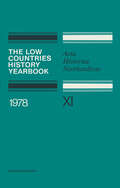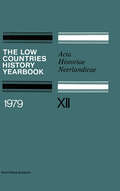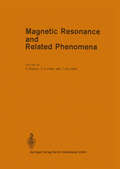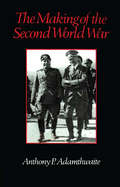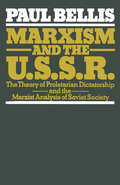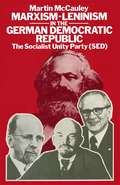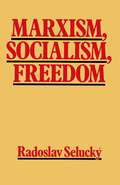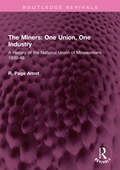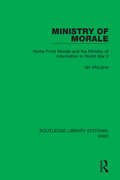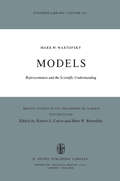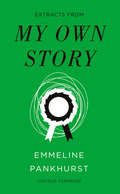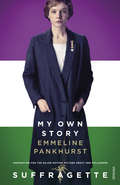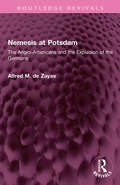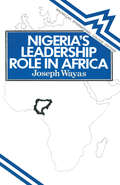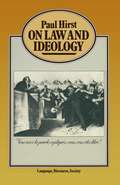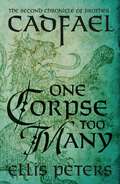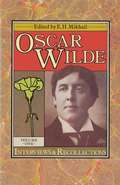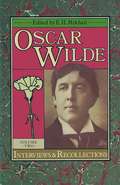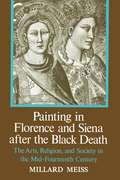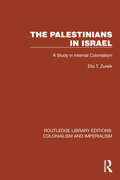- Table View
- List View
Literaturtheorie und Geschichtsphilosophie: Teil I: Aufklärung, Romantik, Idealismus (Sammlung Metzler)
by Dietrich NaumannThe Low Countries History Yearbook 1979: Acta Historiae Neerlandicae
by C. Dekker G. Asaert W. Nijenhuis P. Van Peteghem D. J. Roorda C. R. Emery K. W. Swart K. Van PolsMagnetic Resonance and Related Phenomena: Proceedings of the XXth Congress AMPERE, Tallinn, August 21–26, 1978
by E. Kundla E. Lippmaa T. SaluvereThe Making of the Second World War
by Anthony P. AdamthwaiteFirst published in 1979. Routledge is an imprint of Taylor & Francis, an informa company.
The Making of the Second World War
by Anthony P. AdamthwaiteFirst published in 1979. Routledge is an imprint of Taylor & Francis, an informa company.
Marxism and the U.S.S.R.: The Theory of Proletarian Dictatorship and the Marxist Analysis of Soviet Society
by Paul BellisMarxism-Leninism in the German Democratic Republic (Studies in Russian and East European History and Society)
by Martin McCauleyMarxism, Socialism, Freedom: Towards a General Democratic Theory of Labour-Managed Systems
by Radoslav SeluckyThe Miners: A History of the National Union of Mineworkers 1939-46 (Routledge Revivals)
by R. Page ArnotFirst published in 1979, The Miners: A History of the National Union of Mineworkers 1939-46 describes the events and factors that led to the nationalisation of the coal industry in 1946. The World War had a creative as well as a destructive effect on the industry; it compressed fundamental changes into seven short years. By the end of the war, the federated trade unions had succeeded in bringing about the unification of their industry; and the various county, district and craft associations were themselves also unified in one single national body. Two rival plans emerged during 1945: a coal-owners’ plan, in conjunction with an ‘experts’ report’, approved by Churchill and his Caretaker Cabinet, and Labour’s ‘plan for the coal industry’ which came into force in 1946 as the Coal Industry Nationalisation Act. Anew epoch in management had begun, with a National Coal Board, new industrial relations and a new National Union of Mineworkers. This book will be of interest to students of history, sociology, economics and political science.
The Miners: A History of the National Union of Mineworkers 1939-46 (Routledge Revivals)
by R. Page ArnotFirst published in 1979, The Miners: A History of the National Union of Mineworkers 1939-46 describes the events and factors that led to the nationalisation of the coal industry in 1946. The World War had a creative as well as a destructive effect on the industry; it compressed fundamental changes into seven short years. By the end of the war, the federated trade unions had succeeded in bringing about the unification of their industry; and the various county, district and craft associations were themselves also unified in one single national body. Two rival plans emerged during 1945: a coal-owners’ plan, in conjunction with an ‘experts’ report’, approved by Churchill and his Caretaker Cabinet, and Labour’s ‘plan for the coal industry’ which came into force in 1946 as the Coal Industry Nationalisation Act. Anew epoch in management had begun, with a National Coal Board, new industrial relations and a new National Union of Mineworkers. This book will be of interest to students of history, sociology, economics and political science.
Ministry of Morale: Home Front Morale and the Ministry of Information in World War II (Routledge Library Editions: WW2 #17)
by Ian McLaineThis book, first published in 1979, is an analysis of the wartime Ministry of Information, responsible for the maintenance of public morale. How was it that British morale remained high, yet the department responsible was so bad? This book examines the domestic work of the Ministry and offers an unprecedented insight into the mind of both government and people during the war. It answers key questions: How did a government department assess and set about maintaining morale? How did it handle the social and political questions associated with morale – post-war social reform, press freedom and censorship, the nature of the Soviet regime? How sound in fact was civilian morale, on the basis of the secret Wartime Intelligence reports then available? One of the most fascinating aspects of this book is the Ministry’s constant internal debate on how its responsibilities should best be carried out. It is a key work of research on the political, psychological and mass communications problems facing a society at war.
Ministry of Morale: Home Front Morale and the Ministry of Information in World War II (Routledge Library Editions: WW2 #17)
by Ian McLaineThis book, first published in 1979, is an analysis of the wartime Ministry of Information, responsible for the maintenance of public morale. How was it that British morale remained high, yet the department responsible was so bad? This book examines the domestic work of the Ministry and offers an unprecedented insight into the mind of both government and people during the war. It answers key questions: How did a government department assess and set about maintaining morale? How did it handle the social and political questions associated with morale – post-war social reform, press freedom and censorship, the nature of the Soviet regime? How sound in fact was civilian morale, on the basis of the secret Wartime Intelligence reports then available? One of the most fascinating aspects of this book is the Ministry’s constant internal debate on how its responsibilities should best be carried out. It is a key work of research on the political, psychological and mass communications problems facing a society at war.
Models: Representation and the Scientific Understanding (Boston Studies in the Philosophy and History of Science #48)
by Marx W. WartofskyMarx Wartofsky has been working for many years within an unusual confluence of philosophical problems. He brings to these intersecting problems his comprehensive intelligence, at once imaginative and rigorous, analytic and historical. He is a philosopher's philosopher, but also Everyman's. Wartofsky is philosopher of the natural and the social sciences, of perception, esthetics and the creative arts, of the 18th century French and the 19th century Germans, of politics and morality, ofthe methods and morals of medicine, and it is plain, of all human existence. To a colleague, he seems Jack-of-all-philosophical-trades, and master of them too. The reader soon will learn that Wartofsky is a genial, lucid and relaxed philosophical companion, deeply serious but without noticeable anxiety. I need not highlight these selected epistemological papers gathered as, and about, Models, since Wartofsky's own introductory remarks are helpful and stimulating in that respect. I need only, after 21 years of friendship and collaboration with him, warn the reader to beware of how profound and provocative these papers will show themselves to be beneath their good-humored and swiftly-flowing surface. And I must publicly note the pleasure with which I welcome Marx Wartofsky's volume to our Boston Studies. Boston University R.S.C. Center for the Philosophy and History of Science September 1979 vii TABLE OF CONTENTS EDITORIAL PREFACE VII xi AC K NOWLEDGEMENTS xiii INTRODUCTION The Model Muddle: Proposals for an Immodest Realism 1.
My Own Story (Vintage Feminism Short Editions #No. 5)
by Emmeline PankhurstVintage Feminism: classic feminist texts in short formWITH AN INTRODUCTION BY JESS PHILLIPSSoldier, criminal, militant, hooligan, revolutionary: these labels Emmeline Pankhurst took up and wore proudly in her long struggle for women’s suffrage. This shortened edition of her autobiography tells the inside story of this struggle: the tireless campaigning, the betrayals by men in power, the relentless round of arrests and hunger strikes, the horror of force-feeding. It is a reminder of the controversial means, the indomitable spirit and the sacrifices of life and liberty by which women won their political freedom.ALSO IN THE VINTAGE FEMINIST SHORT SERIES:The Second Sex by Simone de Beauvoir A Vindication of the Rights of Woman by Mary WollstonecraftThe Beauty Myth by Naomi WolfA Room of One's Own by Virginia Woolf
My Own Story: Inspiration for the major motion picture Suffragette (Virago Reprint Library #No. 5)
by Emmeline PankhurstDon't miss Meryl Streep as Emmeline Pankhurst in the major motion picture Suffragette.Emmeline Pankhurst was raised in a world that valued men over women. At fourteen she attended her first suffrage meeting and returned home a confirmed suffragist. Throughout her career she endured humiliation, prison, hunger strikes and the repeated frustration of her aims by men in power but she rose to become the guiding light of the Suffragette movement. This is Pankhurst’s story, in her own words, of her struggle for equality.
Nemesis at Potsdam: The Anglo-Americans and the Expulsion of the Germans (Routledge Revivals)
by Alfred M. ZayasFirst published in 1979, Nemesis at Potsdam discusses the expulsion and spoliation of the Germans from most of central and easter Europe during the Second World War, a process which over two million did not survive. How did this extraordinary event come about? Was it necessary for the peace of Europe? What role did Britain and the United States play in authorizing the ‘transfer’? The book answers these questions and relates the integration of the German expellees to the phenomenal resurgence of West Germany, and traces the development of Ostpolitik and détente through to the Helsinki Declaration. It will be of interest to students of history, international relations, and political science.
Nemesis at Potsdam: The Anglo-Americans and the Expulsion of the Germans (Routledge Revivals)
by Alfred M. ZayasFirst published in 1979, Nemesis at Potsdam discusses the expulsion and spoliation of the Germans from most of central and easter Europe during the Second World War, a process which over two million did not survive. How did this extraordinary event come about? Was it necessary for the peace of Europe? What role did Britain and the United States play in authorizing the ‘transfer’? The book answers these questions and relates the integration of the German expellees to the phenomenal resurgence of West Germany, and traces the development of Ostpolitik and détente through to the Helsinki Declaration. It will be of interest to students of history, international relations, and political science.
One Corpse Too Many: A Morbid Taste For Bones, One Corpse Too Many, And Monk's Hood (The Cadfael Chronicles #2)
by Ellis PetersIn the Summer of 1138, war between King Stephen and the Empress Maud takes Brother Cadfael from the quiet world of his garden to the bloody battlefield.
Oscar Wilde: Interviews and Recollections Volume I (Interviews And Recollections Ser.)
by E. H. MikhailPainting in Florence and Siena after the Black Death
by Millard MeissThe first extended study of the painting of Florence and Siena in the later 14th century, this book presents a rich interweaving of considerations of connoisseurship, style, iconography, cultural and social background, and historical events.
The Palestinians in Israel: A Study in Internal Colonialism (Routledge Library Editions: Colonialism and Imperialism #38)
by Elia T. ZureikThe main focus of The Palestinians in Israel (1979) is the position of the Arab minority in Israel, from being a majority to becoming a minority. By using the framework of internal colonialism, it provides evidence which highlights the social class transformations of the Palestinians in Israel from peasantry to proletariat, the patterns of land alienation, and the nature of inter-ethnic contacts which typify Israeli–Palestinian relations. It looks at Arab social structure in pre-1948 Palestine, discusses the Arabs as they appear in Israeli social science writings, describes the transformation of Arab class structure in Israel, and considers the politicization of Israeli Arabs.

